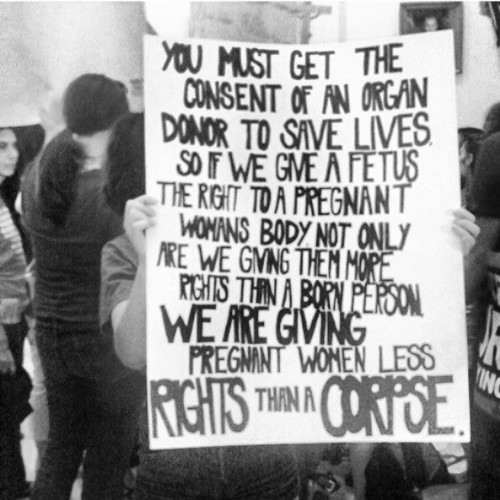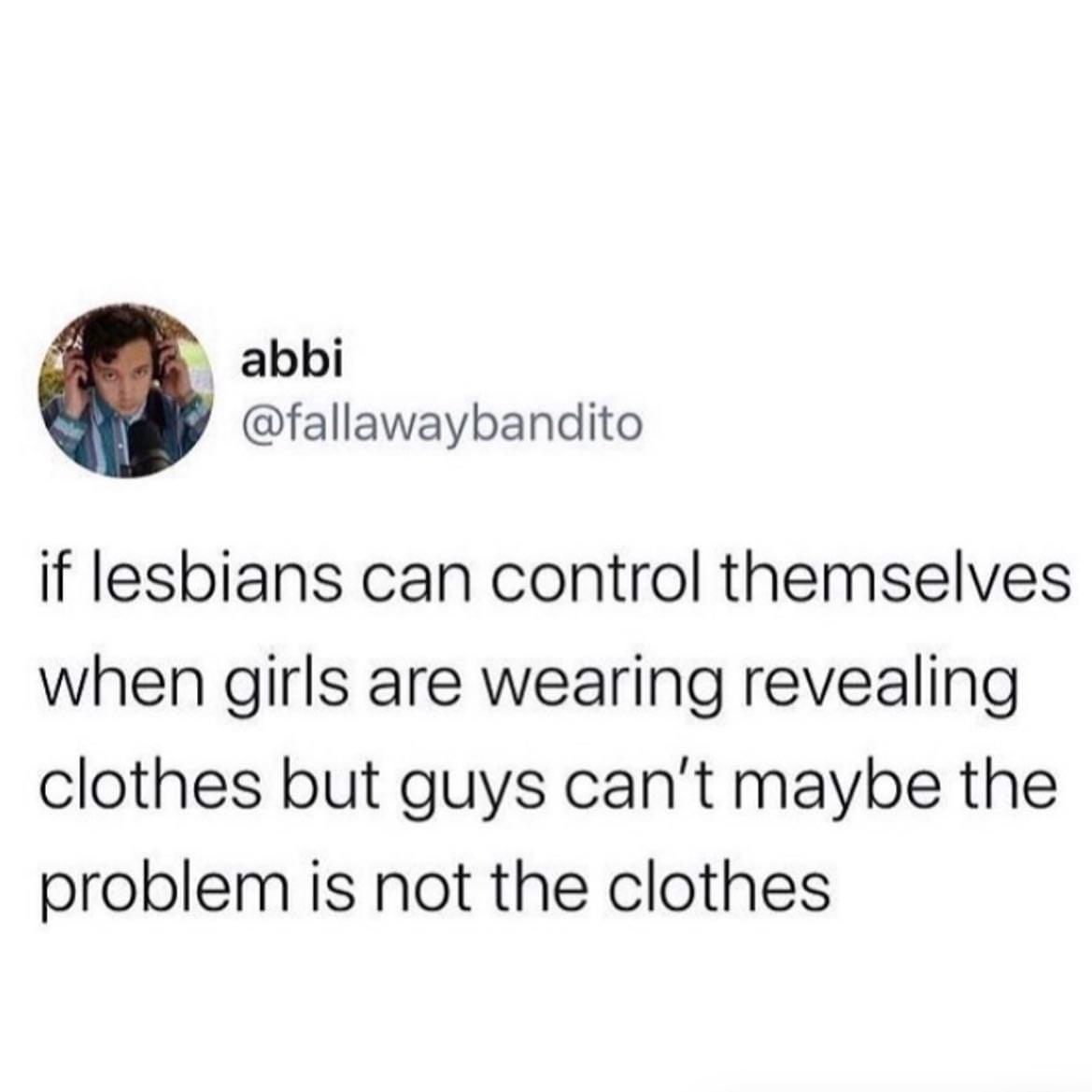“Not to bring up Robert Jensen every three sentences, but he’s made a point that I find extremely salient when it comes to how porn affects women’s lives. If I have to go to court tomorrow, or I have to go discuss my career with my boss, or I have to work on a project at work or school with men, or I have to deal with a cop, or I have to rely in any way on a man in a position of authority to treat me fairly, shouldn’t it worry me to think he might have been watching a film the night before in which a woman has her head shoved into a toilet while someone uses her like a piece of toilet paper? I know some of you may say that the authority figure in question probably wouldn’t be equating me with the woman he jerked off to the night before, but can someone really suspend their sense of empathy long enough to jerk off to an image like that and then see me as an equal human being the next day? Doubtful. And men get together every day to make decisions that affect women’s lives. Men decide whether to promote women, whether to give them raises, whether to hire them, whether to take their claims of sexual harassment seriously, whether to pass a law that hurts or harms their rights to equal pay for equal work, safe and effective health care, etc. “
May 26 2023
(No title)
Recommended!
A few quotes and notes:
“… pregnancy as a proxy for punishment …” (p.x)
But only for the women, even though the men are mostly responsible for causing the pregnancy (males have 100% control over ejaculation in a vagina; females have no control over whatsoever over ovulation and very seldom force a man to ejaculate in her vagina). The impregnator of Sanchez (forced to give birth in a jail cell without any medical assistance) isn’t even mentioned, let alone similarly punished. We need to police the penis.
I read on and am amazed at how absent the man is from all this discussion of pregnancy and abortion. It’s as if pregnancy just comes out of nowhere rather than being the result of a conscious decision on the part of some man.
Instead of decades of books and legal cases agonizing over abortion, why haven’t there been decades of books and legal cases about impregnation? Maybe we should be prohibiting that except in certain circumstances (such as, for starters, the signing of a contract pledging half of the cost of an abortion or childbirth, six years of complete financial support for the child and whoever takes responsibility for looking after it, and another twelve years of half of the financial support for the child).
And about the whole ‘no foreign aid unless you agree NOT to provide abortion or even inform women of contraception’ policies (chap9)—so irrational! Wouldn’t those in charge of providing foreign aid want to encourage abortion? Or at least information about contraception? Because that would reduce the amount of foreign aid required!
“Legislators frame pregnancy as being controlled and conditioned by women.” (p198). Indeed. All of a sudden, men deny agency, deny power. How curious.
May 24 2023
Rereading Refusing to be a Man: essays on sex and justice, John Stoltenberg
Read this years ago, but thought I’d read it again as I hadn’t been able to afford to actually buy it back then …
Talking about how men typically behave, he says they “[disregard] completely the reality of anyone who is not fawning and flattering and full of awe for our masculine prerogative …” (p24).
Well-put.
“… [M]en experience combat as the ultimate test of their masculinity … If we did not hold on so desperately to masculinity, might we not also then be able to let go of warfare?” (p77).
“Though they [men in the antiwar movement] espoused nonviolent, equitable, and nonhierarchical forms of social organization, they continued to act toward women in male-supremacist ways. it became clear that they were interested only in rearrangements of men’s power over other men, not in any fundamental change in men’s relationships with women” (p79).
“Without the absolute right to true reproductive self-determination, women as a class will continue to be exploited and manipulated in service to the economic, sexual, and psychological priorities of men” (p81).
So well-put.
“Men, it is said, do not express their feelings—or if men do, they do so only with great difficulty. Both women and men believe that men are unemotive and unemotional, that inside men’s tender psyches is a wellspring of feelings, stonewalled and speechless. Men respect and fear other men whose feelings are undisclosed and well defended. women also respect and fear such men whose feelings lie dormant beneath a permafrost of mastery. And women who live with them implore them privately to emote just a little, begging them to say what they are feeling, beging them to warm. But men odo not express their feelings. Or so the story goes.
“In fact, throughout history, men as a class have always expressed their feelings, eloquently and extensively: Men have expressed their feelings about women, death, and absent fathers and turned those feeling into religions. Men have expressed their feelings about women, wealth, possession, and territory and turned those feelings into laws and nation-states. men have expressed their feelings about women, murder, and the masculinity of other men and from those feelings forged batttalions and detonable devices. Men have expressed their feelings aobut women, fucking, and female rage against subjection and formed those feelings into psychiatry. men have institutionalized their feelings, so that whether or not a particular man is feeling the feeling at a particular time, the feeling is being expressed through the institutions men have made” (p91-2).
“Given the current frequency of abortions in the United States, it can be predicted that over the course of all American women’s lifetimes, two out of three will have an abortion. And the rate of involvement for men is the same: Over the course of their lifetimes, two out of three men will have been responsible for impregnating a woman who subsequently decides to abort.”
Of course! For almost every abortion there is a nonconsensual impregnation, a whachamacallit, a … rape. If men didn’t rape, women wouldn’t need an abortion. So men, those of you who are so against abortion, stop impregnating women who are not enthusiastically consenting to having a child! Duh!!
“The history of men’s ideas is the history of what men feel and the history of what men feel to be real. As a class, men never feel more real than when their penises are erect and penetrating—and never feel less real than when their penises are flaccid. As a result, men’s ideas about what is real, what is objectively as real as themselves, tend to be utterly self-referential and almost entirely phallocentric” (para 97).
Wow. Just— Wow. That explains sooooooooooo much. An argument against men in power if there ever was one.
“…men don’t like the feeling of not feeling like having sex. … It’s as if men don’t really feel their male identity unless they’re experiencing their own body in a way that is explicitly, culturally, sexually phallic” (p110-111).
Aha. I’ve never really understood viagra etc.: here’s a tube of poison ivy sap; go ahead and spread it all over your body. Why would you want to create an itch, a desire to scratch? Don’t you have enough to do with meeting the itches and desires you already … just have?
“Sexual freedom has never really meant that individuals should have sexual self-determination … it has been about maintaining men’s superior status, men’s power over women; and it has been about sexualizing women’s inferior status, men’s subordination of women” (p127).
“Pornography institutionalizes the sexuality that both embodies and enacts male supremacy. … Pornography keeps sexism sexy” (p129-130)
“Homophobia keeps men doing to women what they would not want done to themselves. There’s not the same sexual harassment of men that there is of women on the street or in the workplace or in the university; there’s not nearly the same extent of rape … And that’s thanks to homophobia …”
“We’ve got to be telling our sons that if a man gets off by putting women down, it’s not okay.
“We’ve got to be telling merchants tha tif they peddle women’s bodies and lives for men’s consumption and entertainment, it’s not okay.
“We’ve got to be telling other men that if you let th epornographers lead you by the nose (or any other body part) into believing that women exist to be tied up and hung up and beaten and raped, it’s not okay” (p135).
And keep in mind that he wrote this thirty years ago.
Lastly, “If it’s true that men are the doers, the agents of history, the performers, the active ones, how come men are so passive [when it comes to women’s rights]? (p183).
May 10 2023
from Jack Holland’s A Brief History of Misogyny
Apr 25 2023
Like night and day indeed.
Apr 22 2023





















